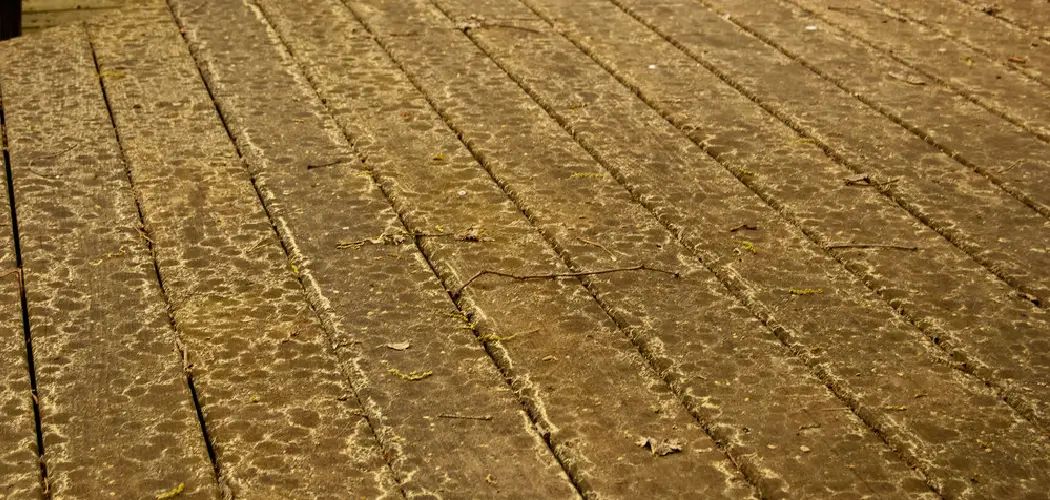As summer approaches and the weather warms up, many of us are looking forward to spending more time in our backyards. Whether you spend your afternoons relaxing on a lounger or grilling dinner, your deck will surely be an essential part of the experience.

Unfortunately, one common downside of warm weather is pollen. Pollen can leave decks looking dull and dingy when allowed to accumulate over time. Suppose you want to take control of your outdoor space this season. In that case, it’s important that you learn how to remove pollen from your deck so you can enjoy an inviting area for leisurely activities or entertaining guests–while protecting its beauty and longevity!
In today’s article, we will provide some helpful tips on how to remove pollen from deck without damaging the material below.
Why is Removing Pollen Important?
Pollen may seem innocuous, but its presence on your deck can lead to more significant problems. When pollen combines with moisture or rain, it creates a breeding ground for mold and mildew. These growths can cause wood to rot over time and compromise the structural integrity of your deck.
In addition, pollen also attracts bugs such as ants and termites, which can cause further damage to your deck. Not only that, but pollen can make your deck slippery and hazardous when wet, posing a safety risk for you and your family.
Now that we understand the importance of removing pollen from our decks let’s dive into some methods on how to do so effectively.
What Will You Need?
Before you begin, gather the following supplies together:
- Garden hose with adjustable nozzle
- Broom or leaf blower for sweeping
- Mild detergent or deck cleaner
- Soft-bristled brush or mop
- Bucket
- Rubber gloves (optional)
Once you have everything you need, it’s time to get started.
10 Easy Steps on How to Remove Pollen From Deck
Step 1: Sweep Off Any Loose Pollen
Start by sweeping off loose pollen from your deck using a broom or leaf blower. If there is a large amount of pollen, consider investing in a leaf blower, as it will make the task much easier and faster. Try to sweep in the direction of the grain of your deck boards.
Step 2: Rinse the Deck
After sweeping the loose pollen, the next step is to rinse the deck. Using your garden hose with an adjustable nozzle, begin rinsing your deck from top to bottom and from one end to the other. This pre-rinse will help to remove any remaining loose pollen further and prepare the deck for deep cleaning. Ensure to rinse in the direction of the drain to avoid water pooling on your deck. Be careful not to use a high-pressure setting as it can damage the wood.
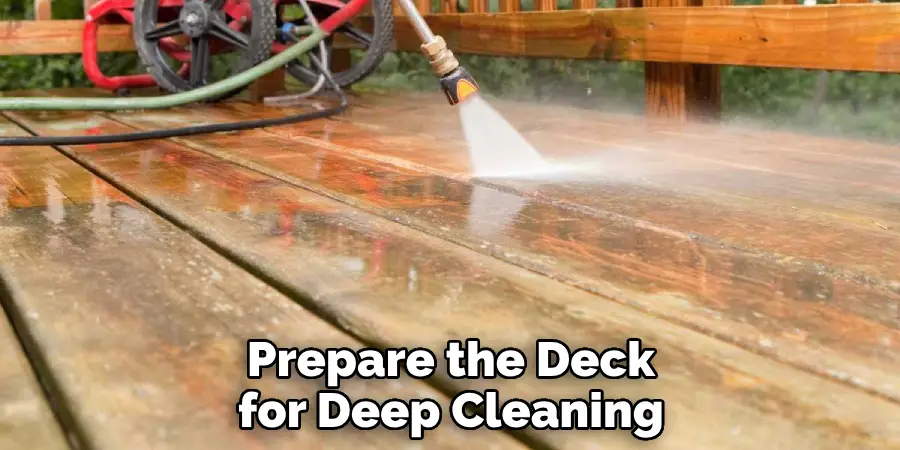
Step 3: Prepare Cleaning Solution
Now, fill your bucket with water and add a mild detergent, or use a specially formulated deck cleaner to create a cleaning solution. Make sure to follow the manufacturer’s instructions regarding the correct ratio of water to cleaner. If you’re using detergent, a good rule of thumb is to add half a cup of detergent to one gallon of water. Stir until the solution is well mixed.
Step 4: Scrub the Deck
Next, dip your soft-bristled brush or mop into the cleaning solution and scrub the deck. Make sure to scrub thoroughly but gently, focusing on the areas where pollen is most visible. Scrub in the direction of the grain of the deck boards to avoid damaging the wood. As you scrub, the detergent or deck cleaner in the solution will loosen the pollen, making it easier to rinse away.
Step 5: Rinse Off the Cleaning Solution
Once you have finished scrubbing the deck, it’s time to rinse off the cleaning solution. Using your garden hose, thoroughly rinse your deck from top to bottom, ensuring you remove all the detergent or deck cleaner.
Again, rinse in the direction of the drain to prevent water from pooling.
As you rinse, you will see the loosened pollen washing away, leaving your deck clean and refreshed. It’s important to remove all the cleaning solutions to avoid any residues that could potentially damage your deck over time.
Step 6: Let the Deck Dry
After the thorough rinse, it’s crucial to let your deck dry completely before using it again. This process may take several hours or even a full day, depending on the weather and sunlight. A dry deck ensures that any residual moisture that could encourage mold and mildew growth is eliminated.
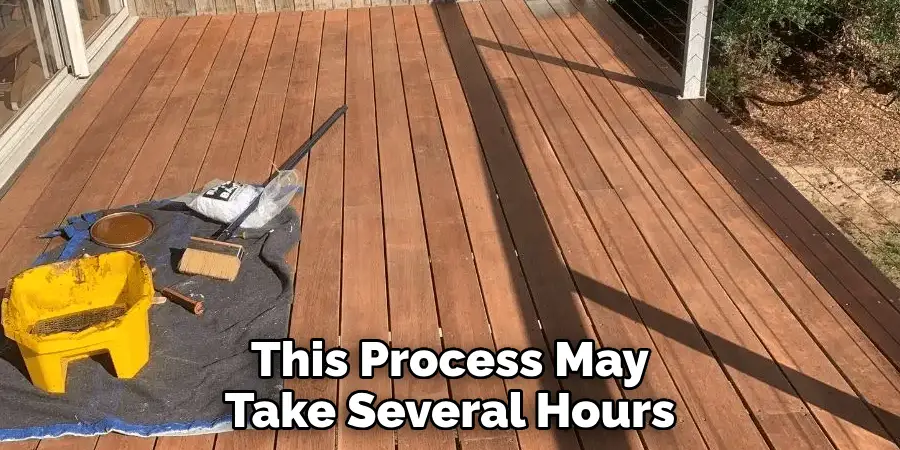
Choose a sunny day for your cleaning task to speed up the drying process. Once the deck is dry, inspect it for any spots you may have missed during the cleaning. If necessary, repeat the steps to address these areas.
Step 7: Regular Maintenance
Regular cleaning can help prevent pollen build-up on your deck. It’s advisable to sweep the deck regularly, especially during the pollen season. If you notice a fresh layer of pollen, quickly rinse it off with your garden hose. This proactive approach will minimize the need for deep cleaning and keep your deck looking its best.
Step 8: Consider Applying a Deck Sealer
Applying a deck sealer can offer added protection from pollen, as well as other types of dirt and debris. Sealers provide a protective layer on the surface of the wood, making it more difficult for pollen to stick to the deck. Make sure to select a sealer appropriate for the type of wood your deck is made of, and follow the manufacturer’s instructions for application.
Step 9: Use Furniture and Plant Covers
Another effective strategy to reduce pollen accumulation on your deck is to use covers for your outdoor furniture and plants. When not in use, covering these items will help to decrease the amount of pollen that settles on the surfaces. Be careful not to use plastic covers, as they can trap moisture and cause damage to your deck.
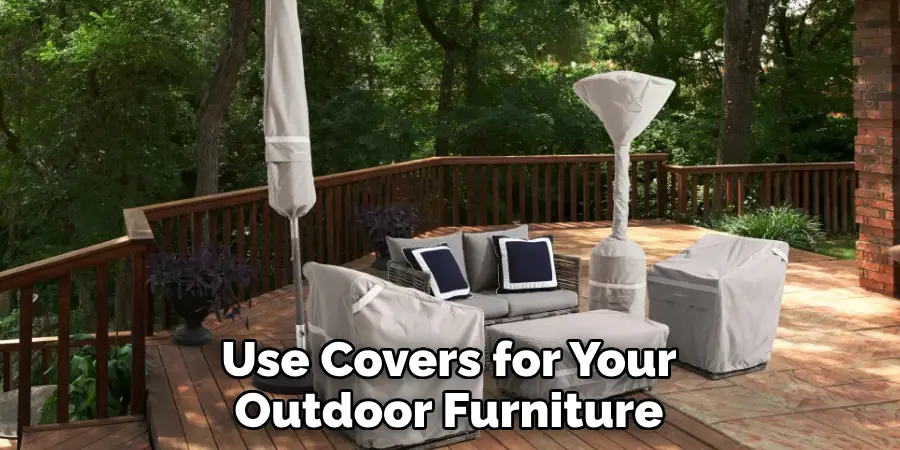
Step 10: Enjoy Your Clean Deck
Finally, after following these steps, it’s time to enjoy your clean and inviting deck. Regular maintenance will keep this outdoor space comfortable and ready for use throughout the warm season. Remember, removing pollen from your deck not only improves its appearance but also increases its lifespan, ensuring you and your family can enjoy it for years to come.
Following these simple steps, you can easily remove pollen from your deck and maintain its beauty and durability. With a little effort and regular maintenance, your deck will be an inviting space for relaxation, family gatherings, and outdoor activities.
5 Additional Tips and Tricks
- Regular Cleaning: Regularly sweep your deck to prevent pollen accumulation. Using a high-quality outdoor broom can make the task quicker and more efficient.
- Use of Leaf Blower: If the pollen invasion is extensive, consider using a leaf blower. This can swiftly remove large quantities of pollen from your deck area.
- Hose it Down: A quick and effective way to remove pollen from your deck is by hosing it down with water. Ensure to use a nozzle with a high-pressure setting for better results.
- Deck Cleaner: Use a specially formulated deck cleaner to treat areas stained by pollen. Always follow the manufacturer’s instructions regarding dilution and application.
- Try out a Pressure Washer: For stubborn pollen stains, you can use a pressure washer on your deck. Be cautious with the pressure setting, as too much force can damage the wood surface.
With these additional tips and tricks, you can easily remove pollen from your deck and keep it looking clean all season long.
5 Things You Should Avoid
- Avoid Ignoring Pollen Buildup: Allowing pollen to accumulate on the deck can lead to stubborn stains and potential damage. It is essential to remove pollen promptly.
- Don’t Use Harsh Chemicals: Avoid using bleach or other harsh chemicals, as they can damage the deck’s finish and harm the surrounding vegetation.
- Avoid Power Washing Incorrectly: When using a power washer, don’t hold the nozzle too close to the deck or use excessively high pressure, which can damage the wood.
- Don’t Skip Safety Measures: Wear protective gear such as gloves and safety glasses when using power tools or handling cleaning chemicals.
- Avoid Leaving Wet Debris: After washing your deck, ensure not to leave wet leaves or other debris on the surface as they can trap moisture, promoting mold growth and deck decay.
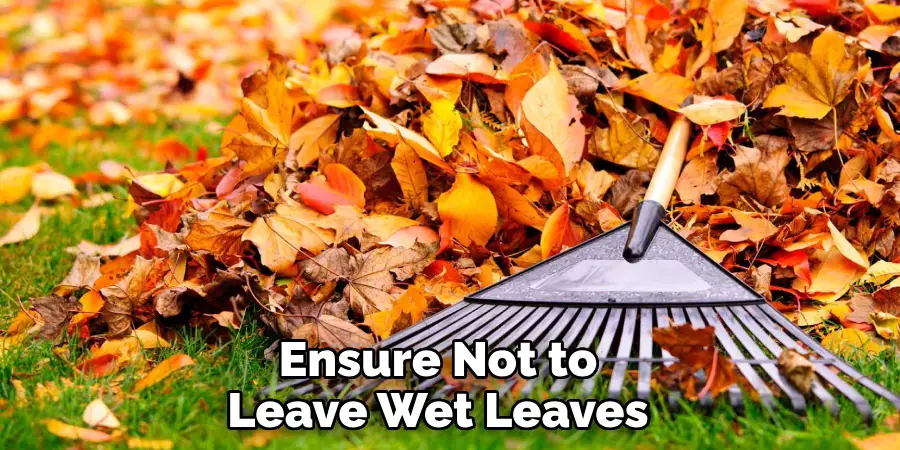
By avoiding these common mistakes, you can effectively and safely remove pollen from your deck without causing damage or harm.
What Causes Pollen?
Pollen is a fine, yellowish powder plants produce as part of their reproductive process. It is released into the air and can easily travel long distances with the help of wind or insects. Pollen production increases during spring and summer when plants fully bloom, making it a common allergen for many people.
Another factor that contributes to pollen accumulation on decks is the use of certain types of wood. For example, cedar and redwood are less susceptible to pollen build-up, while softer woods like pine or fir may attract more pollen due to their porous nature.
Moreover, the location of your deck can also play a role in how much pollen it accumulates. If trees and plants surround your deck, it is more likely to be covered with pollen than a deck in an open area.

Ultimately, pollen is a natural occurrence and must be partially avoided. However, with proper maintenance and regular cleaning, you can easily remove it from your deck and create a comfortable outdoor space without any worries of allergies or unsightly stains.
Is Pollen Harmful to Humans?
Pollen is not only a nuisance for our decks but can also be problematic for individuals who suffer from allergies or asthma. Inhaling pollen can cause sneezing, runny nose, itchy eyes, and difficulty breathing. If you are highly sensitive to pollen, it’s best to stay indoors during high pollen days and avoid direct contact with it whenever possible. It’s also a good idea to consult with your doctor for appropriate treatment options if you experience severe allergic reactions to pollen.
Additionally, pollen can also trigger allergic reactions in pets, so it’s essential to keep your deck clean and pollen-free for their health.
Overall, pollen may not harm everyone, but it’s always best to take precautions and keep your outdoor space clean and free of pollen. With these tips and tricks, you can easily maintain a beautiful and allergy-free deck all season long.
Does Pollen Stain Permanently?
Pollen stains can appear stubborn and challenging to remove, but in most cases, they are not permanent. With the proper cleaning methods and tools, you can easily remove pollen from your deck without causing any damage. Taking preventive measures such as regular maintenance and applying a sealer can also help prevent future staining.
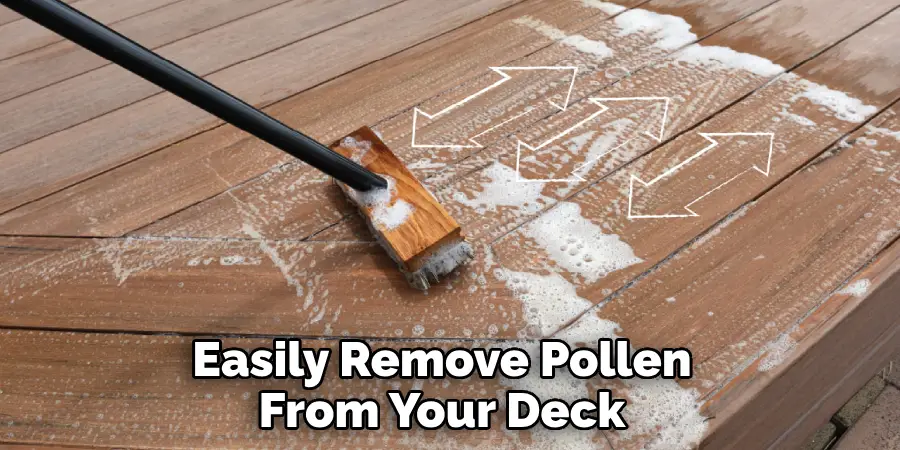
Additionally, it’s essential to address pollen stains as soon as possible to avoid them from setting in and becoming more challenging to remove. With proper care and maintenance, you can keep your deck looking clean and beautiful all season.
Conclusion
To conclude, removing pollen from your deck is a challenging task. It takes time and patience to get the job done correctly. Ensure that you are wearing protective clothing while attempting this tedious chore and use a variety of methods to get rid of pollen build-up successfully. Whether you choose to utilize a power washer, cleaner or sweeper or decide to scrub the pollen away manually is entirely up to you.
In any case, don’t give up; the result will be worth it! With the proper techniques and effort, this spring season can create a gorgeous outdoor space for you and your family to enjoy. So don’t let pollen stand in the way of having a great time—take action today!
Hopefully, the article on how to remove pollen from deck has given you the necessary information and tips to effectively maintain a clean and beautiful deck all season long. With proper care, you can keep your outdoor space looking its best and enjoy spending time on your deck without any worries or hassle. Happy cleaning!
About
Outdoor Fixes is a distinguished figure in the world of Diy design, with a decade of expertise creating innovative and sustainable Diy solutions.
His professional focus lies in merging traditional craftsmanship with modern manufacturing techniques,
fostering designs that are both practical and environmentally conscious. As the author of diy,
outdoorfixes delves into the art and science of outdoorfixes-making, inspiring artisans and industry professionals alike.
Education RMIT University
(Melbourne, Australia) Associate Degree in Design (Outdoor Fixes) Focus on sustainable design, industry-driven projects,
and practical craftsmanship. Gained hands-on experience with traditional and digital manufacturing tools, such as CAD and CNC software.
Nottingham Trent University
(United Kingdom) Bachelor’s in outdoorfixes.com and Product Design (Honors) Specialized in product design with a focus on blending creativity with production
techniques. Participated in industry projects, working with companies like John Lewis and Vitsoe to gain real-world insights.
Publications and Impact
In diy, Outdoor Fixes his insights on indoor design processes, materials, and strategies for efficient production.
His writing bridges the gap between artisan knowledge and modern industry needs, making it a must-read for both budding designers and seasoned professionals.

